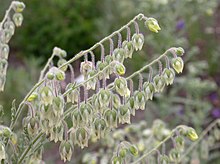Emmenanthe
| Emmenanthe | |
|---|---|

| |
| Scientific classification | |
| Kingdom: | Plantae |
| Clade: | Tracheophytes |
| Clade: | Angiosperms |
| Clade: | Eudicots |
| Clade: | Asterids |
| Order: | Boraginales |
| Family: | Boraginaceae |
| Subfamily: | Hydrophylloideae |
| Genus: | Emmenanthe Benth. |
| Species: | E. penduliflora
|
| Binomial name | |
| Emmenanthe penduliflora Benth.
| |
Emmenanthe is a monotypic genus which contains only one species, Emmenanthe penduliflora, known by the common name whispering bells.[1] This grassland wildflower is native to California, though it can also be found in other locations within western North America.[1]
Description
Emmenanthe is monotypic genus of annual plants with fleshy foliage which exudes a sticky juice with a light medicinal odor.[2] The plant comes up from a weedy-looking basal rosette of sharply lobed leaves. Inflorescence is a terminal cluster of flowers, borne on slender pedicels less than 1 inch long. Blooms have five sepals and five yellow or pinkish petals in a bell-shaped. Flowers dry and become light and papery. The dry hanging flowers make a rustling sound when a breeze comes through, giving the whispering bells its common name. The dry flower also contains a fruit about a centimeter wide.
Habitat
This flower is most common in dry, recently burned areas; germination of the seeds may be triggered by the presence of burned plant material. It is a common plant of the chaparral ecosystem, which is prone to wildfire.
References
- ^ a b "Emmenanthe penduliflora". Calflora: Information on California plants for education, research and conservation, with data contributed by public and private institutions and individuals, including the Consortium of California Herbaria. Retrieved 9 November 2019.
- ^ Robert Patterson & Richard R. Halse. "Emmenanthe penduliflora". The Jepson Herbarium - University of California, Berkeley. Retrieved 9 November 2019.
